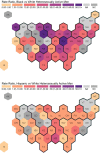Racial and ethnic disparities in HIV diagnoses among heterosexually active persons in the United States nationally and by state, 2018
- PMID: 34543322
- PMCID: PMC8451999
- DOI: 10.1371/journal.pone.0257583
Racial and ethnic disparities in HIV diagnoses among heterosexually active persons in the United States nationally and by state, 2018
Abstract
Background: Despite declining HIV infection rates, persistent racial and ethnic disparities remain. Appropriate calculations of diagnosis rates by HIV transmission category, race and ethnicity, and geography are needed to monitor progress towards reducing systematic disparities in health outcomes. We estimated the number of heterosexually active adults (HAAs) by sex and state to calculate appropriate HIV diagnosis rates and disparity measures within subnational regions.
Methods: The analysis included all HIV diagnoses attributed to heterosexual transmission in 2018 in the United States, in 50 states and the District of Columbia. Logistic regression models estimated the probability of past-year heterosexual activity among adults in three national health surveys, by sex, age group, race and ethnicity, education category, and marital status. Model-based probabilities were applied to estimated counts of HAAs by state, which were synthesized through meta-analysis. HIV diagnoses were overlaid to calculate racial- and ethnic-specific rates, rate differences (RDs), and rate ratios (RRs) among HAAs by sex and state.
Results: Nationally, HAA women have a two-fold higher HIV diagnosis rate than HAA men (rate per 100,000 HAAs, women: 6.57; men: 3.09). Compared to White non-Hispanic HAAs, Black HAAs have a 20-fold higher HIV diagnosis rate (RR, men: 21.28, women: 19.55; RD, men: 15.40, women: 31.78) and Hispanic HAAs have a 4-fold higher HIV diagnosis rate (RR, men: 4.68, RD, women: 4.15; RD, men: 2.79, RD, women: 5.39). Disparities were ubiquitous across regions, with >75% of states in each region having Black-to-White RR ≥10.
Conclusion: The racial and ethnic disparities across regions suggests a system-wide failure particularly with respect to preventing HIV among Black and Hispanic women. Pervasive disparities emphasize the role for coordinated federal responses such as the current Ending the HIV Epidemic (EHE) initiative.
Conflict of interest statement
The authors have declared that no competing interests exist.
Figures





References
-
- The White House. National HIV/AIDS Strategy [Internet]. 2020. [cited 2020 Apr 27]. Available from: https://www.hiv.gov/federal-response/national-hiv-aids-strategy/strategy....
-
- National Alliance of State and Territorial AIDS Directors. Ending the HIV epidemic: jurisdictional plans [Internet]. Available from: https://www.nastad.org/maps/ending-hiv-epidemic-jurisdictional-plans.
-
- McCree DH, Chesson HW, Eppink ST, Beer L, Henny KD. Changes in racial and ethnic disparities in estimated diagnosis rates of heterosexually acquired HIV infection among heterosexual males in the United States, 2014–2018. J Acquir Immune Defic Syndr. 2020Dec15;85(5):588–92. doi: 10.1097/QAI.0000000000002495 - DOI - PubMed
Publication types
MeSH terms
LinkOut - more resources
Full Text Sources
Medical
Miscellaneous

